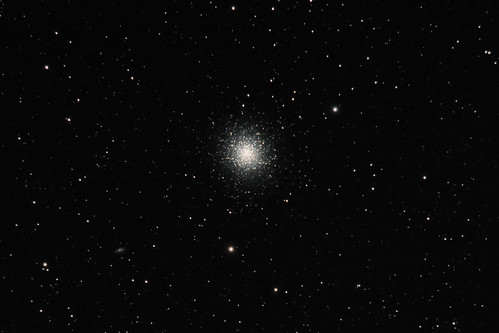18 – 19 May 2018, 22:30 – 02:00 BST
The sky was a little hazy and never completely dark, so for the most part I stuck to the bright showpiece objects. Best views came with the 9 mm Nagler – darker sky, better contrast. The scope took a good hour to cool down, but when it did the views were spectacular.
M13, great globular cluster in Hercules
In a word: wow! After switching from the 24 mm Panoptic to the 9 mm Nagler, pinpoint stars were resolved (in direct and averted vision) right across the face of the cluster, giving an impressive sense of scale and distance. After a while I could perceive chains of stars curving out from the centre. The first night was supposed to be a whistle-stop tour of some old favourites but I couldn’t tear myself away from this object. The longer I looked, the better the view got. I've viewed M13 many times with the 4-inch scope but now for the first time I could see it as a proper cluster of stars and not just a grainy snowball hovering on the threshold of resolution. (The photo above really doesn't do the spectacle justice.) At one point a satellite (space junk?) glided right across the middle of the cluster, followed a minute or two later by a second object travelling on the same path.
M57, Ring Nebula in Lyra
Very bright outer "donut", gauzy central region, brighter edge on one of the long sides. Faint star clearly seen adjacent to nebula.
M5, globular cluster in Serpens
Easier to find than I thought it would be. Smaller, more condensed than M13, but the XT10 resolved it well despite it being in a brighter part of the sky. Relatively bright star just off centre. It seemed (and I’ve thought this before with the Vixen SP-102) that although M13 is bigger and brighter overall, the brightest stars in M5 are brighter than the brightest ones in M13.
M81 and M82, pair of galaxies in Ursa Major
Not well-placed for observing now, but I couldn't resist looking at the Great Bear's famous galaxy pair. M81 showed a bright condensed core and not much else (I’ve no doubt the outer structure will be more evident on a better night). M82 was a surprisingly long streak of light (making me look forward to the likes of NGC 891, etc.) and the bisecting dark lane was clearly visible.
Despite its low altitude this year, Jupiter in the XT10 was as good as I’ve ever seen it. It was dazzlingly bright with the 9 mm Nagler, but the best view came with the 5 mm Nagler. Alt-Az tracking wasn’t any problem either, although it helped that it was near the meridian. Fleeting moments of good seeing revealed plenty of fine detail in and around the belts, with a noticeable “kink” in the NEB. The GRS was immediately obvious and – once my eye had adjusted to the brightness – its brick red hue stood out. All four Galilean moons were visible, but with no obvious signs of colour or resolution.
Veil Nebula, supernova remnant in Cygnus
I switched back to the 24 mm Panoptic for this one. As I anticipated, the sky wasn’t dark enough to see it with direct vision, but when I added the Ultrablock filter it immediately popped out. The Witch’s Broom (running through 52 Cyg) looked like a funnel cloud frozen in space, tapering to a sharp point. I had to sweep to find the other section, but again it popped out from the dark background, showing the distinct “chicken-bone” shape familiar from photographs, and a suggestion of a braided structure.
M27, Dumbbell Nebula in Vulpecula
Very bright with or without the Ultrablock. Appeared sharper on one side and ever so slightly bluer than M57. I need to spend more time on this object, but it's already clear that the XT10 is going to be an excellent scope for high-magnification viewing of planetary nebulae.
M71, globular cluster in Sagitta
Quick look, partly resolved. Loose for a globular.
NGC 6939, open cluster in Cepheus
Partially resolved, triangular shape. Appearance much the same as the photo I took recently.
Albireo, double star in Cygnus
One of the northern sky's showpiece doubles. Improved as it gained altitude; looked better at 50x, but perhaps the brightness was overwhelming the colours a little.
M51 and NGC 5195, Whirlpool Galaxy and companion in Canes Venatici
Again, not well placed, but both galaxies showed bright cores. A hint of spiral arm structure in M51, with a star superimposed over the face of the galaxy (definitely not a supernova).
Other impressions: lots of satellites/space junk seen passing through the field of view, often in pairs (According to Stellarium the brighter ones were from the GlobalStar family). The night included a very bright ISS passage - almost overhead - and visible most of the way down to the horizon.


No comments:
Post a Comment